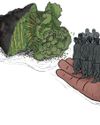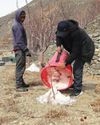
THE ICONIC images of Garhwali peasant women hugging trees, apparently to protect them from being cut down, have become synonymous with the Chipko movement. Perceptions of the movement that have also become popular are its ecological and feminist forms. However, these are only misconceptions that overshadow the real and initial objectives of a people's movement for rights over local forests.
The movement began in 1973 in Uttarakhand, then a part of Uttar Pradesh, by communities in the Garhwal Himalaya region against commercial tree-felling that led to degradation of forests and natural disasters. Their demands were clear: abolish the contract system of tree-felling and establish the rights of communities over the management and use of forests. Their aim was to develop local economies by promoting small-scale forest-based industries, while ensuring forest conservation. However, "the ecological and feminist form of Chipko was invented" in 1977-79, as writes historian Shekhar Pathak in The Chipko Movement: A People's History. This shift came when Sundarlal Bahuguna, considered a pioneer of Chipko, demanded "a complete ban on tree felling" in line with his perception of deep ecology.
The feminist image, on the other hand, was created due to a single incident that social activist from Uttarakhand Vandana Shiva highlighted in her book without context.
The 1988 book, Staying Alive: Women, Ecology and Development, introduces Bachni Devi as protesting in Adwani forest against her husband, described as contractor Sunderlal Saklani. Shiva identified it as "the most dramatic turn in the new confrontation," perceiving it as the rise of a gender conflict. But historical facts show that the movement had gender collaboration.
هذه القصة مأخوذة من طبعة September 16, 2024 من Down To Earth.
ابدأ النسخة التجريبية المجانية من Magzter GOLD لمدة 7 أيام للوصول إلى آلاف القصص المتميزة المنسقة وأكثر من 9,000 مجلة وصحيفة.
بالفعل مشترك ? تسجيل الدخول
هذه القصة مأخوذة من طبعة September 16, 2024 من Down To Earth.
ابدأ النسخة التجريبية المجانية من Magzter GOLD لمدة 7 أيام للوصول إلى آلاف القصص المتميزة المنسقة وأكثر من 9,000 مجلة وصحيفة.
بالفعل مشترك? تسجيل الدخول

THE GREAT FARM HUSTLE
Agroforestry is fast emerging as a win-win strategy to mitigate climate change and improve farmers' income. It is particularly so in India, home to one-fifth of the agroforestry carbon projects in the world. Over the past months ROHINI KRISHNAMURTHY has travelled to almost 20 villages across the country to understand how this market works. At all locations, she finds that communities and their land and labour are central to the projects. But they do not always benefit from the carbon revenue

CAN AGROFORESTRY CREDITS BE SAVED?
Ensure that farmers benefit from the carbon revenue and stay protected against market failure

Urban trap
Fearing loss of autonomy and access to government schemes, several villages across India are protesting against the decision to change their status to town

Dubious distinction
How Madhya Pradesh displaced Punjab as the country's leading state in stubble burning

TRADE TENSIONS
Why the benefits of agroforestry carbon trade do not trickle down to farmers

A fantastical lens
BIOPECULIARIS A LAUDABLE ATTEMPT TO CARVE A SPACE FOR SPECULATIVE CLIMATE FICTION WITHIN INDIAN LITERATURE. WHILE THE STORIES MAY NOT ALWAYS HIT THEIR MARK, THE ANTHOLOGY IS AN IMPORTANT STEP IN A GENRE THAT DESERVES MORE ATTENTION

Help on hold
US' decision to pause foreign aid could lead to hunger deaths, ruin economies of nations across Africa

Irrigation by snow
Declining rain and snowfall make farmers collect snow from higher altitudes to water their apple crops

Stem the rot
A fungal disease has hit the most widely sown sugarcane variety in Uttar Pradesh, threatening the country's sugar production

The mythos of ancient India's scientific excellence
Policymakers are obsessed by a fuddled idea of resurrecting a glorious civilisational past, and even IITs have fallen in line